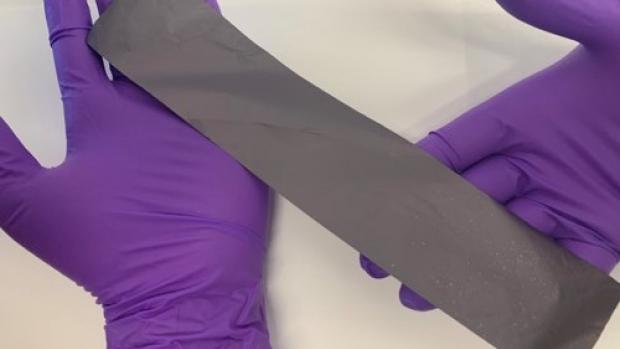Researchers devise efficient, scalable process for fabricating MXene films that block electromagnetic interference

With the boom in wearable electronics, Internet of Things devices and more, coatings that block electromagnetic radiation are becoming a critical part of the manufacturing process. Andre ́ D. Taylor and Ph.D. student Jason Lipton have devised an efficient, speedy way to make such coatings with MXene 2D transition metal carbides.
BROOKLYN, New York, Thursday, August 6, 2020 – The proliferation and miniaturization of electronics in devices, wearables medical implants and other applications has made technologies for blocking electromagnetic interference (EMI) especially important, while making their implementation more challenging. While EMI can cause disruptions in communication in critical applications, resulting in potentially disastrous consequences, traditional EMI shields require large thicknesses to be effective, hampering design flexibility.
One solution resides in MXenes, a family of 2D transition metal carbides, nitrides, and carbonitrides with potential for blocking EMI demonstrate high conductivity and excellent EMI shielding properties. The key to the commercialization of these materials is industry-scale manufacturing.
A multi-institution research team led by Andre ́ D. Taylor, professor of chemical and biomolecular engineering at the NYU Tandon School of Engineering demonstrated a novel approach to MXene fabrication that could lead to methods for at-scale production of MXene freestanding films: drop-casting onto prepatterned hydrophobic substrates. Their method led to a 38% enhancement of EMI shielding efficiency over conventional methods. The work, “Scalable, Highly Conductive, and Micropatternable MXene Films for Enhanced Electromagnetic Interference Shielding,” published in the first-anniversary issue of the Cell Press publication Matter, suggests that micropatterned MXene films, prepared using a method that is scalable and allows for high throughput, can be readily used in EMI shielding, energy storage, and optoelectronics applications.
The team, including lead author Jason Lipton, a Ph.D. candidate under the guidance of Taylor, as well as Elisa Riedo of NYU Tandon, Yury Gogotsi from Drexel University and researchers at the Brookhaven National Laboratory, cast aqueous dispersions of MXene nanosheets (with the formula Ti3C2Tx) on hydrophobic polystyrene substrates and dried them. After drying, the resulting free-standing films could be easily peeled off, a method demonstrating a variety of advantages over the conventional vacuum-assisted filtration method with regards to time efficiency, operation simplicity, and surface smoothness.
Taylor said the beauty of the drop-casting method lies in its ability to allow for modulation of micrometer-scale 3D patterns on the film surface by utilizing pre-patterned substrates (such as a vinyl record, retroreflective packaging, and retroreflective tape). He added that the research leads toward more sustainable production.
“Our work illustrates how MXene nanoflakes can be manufactured into free-standing films without the need for complicated and energy-consuming instruments.”
Lipton added that a critical benefit of the process is that allows for better control the thin film configuration of Ti3C2Tx (including the lateral size and the thickness).
“The conventional wisdom for making MXene films is that you should match a hydrophilic material with a hydrophilic substrate to get a smooth coating,” said Lipton. “We found that if you instead try to use a hydrophobic surface it results in simple, scalable production of freestanding films because the MXenes prefer to stick together than interact with the surface. Because there are many commercially available microstructured plastics, there are a lot of options to make a 3D-patterned MXene film, and we find that choosing the right pattern can dramatically improve EMI shielding effectiveness. This opens up a lot of opportunities to study different micro-structured MXene composites for wide-ranging applications”
“The proof of concept marks an essential step towards the massive production of Ti3C2Tx films, which opens a bright venue to accelerate the commercialization of MXene products,” added Taylor.
The work was supported by a U.S. Department of Energy Office of Science Graduate Research Fellowship, (SCGSR).
“Scalable, Highly Conductive, and Micropatternable MXene Films for Enhanced Electromagnetic Interference Shielding” is available at: https://www.cell.com/matter/fulltext/S2590-2385(20)30290-3
About the New York University Tandon School of Engineering
The NYU Tandon School of Engineering dates to 1854, the founding date for both the New York University School of Civil Engineering and Architecture and the Brooklyn Collegiate and Polytechnic Institute (widely known as Brooklyn Poly). A January 2014 merger created a comprehensive school of education and research in engineering and applied sciences, rooted in a tradition of invention and entrepreneurship and dedicated to furthering technology in service to society. In addition to its main location in Brooklyn, NYU Tandon collaborates with other schools within NYU, one of the country’s foremost private research universities, and is closely connected to engineering programs at NYU Abu Dhabi and NYU Shanghai. It operates Future Labs focused on start-up businesses in downtown Manhattan and Brooklyn and an award-winning online graduate program. For more information, visit engineering.nyu.edu.




